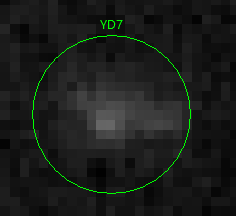The Big Bang occurred around 13.6 billion years ago. This is supported through the analysis of cosmic microwave background, thermal radiation left over from the Big Bang. Thousands of years after the Big Bang, young stars formed and died, and eventually they grouped up together, forming the first young galaxies. The goal of my project is to discover the first galaxies to form in the 13.6 billion year old history of the Universe. Most of the data of my project is collected from the Hubble Frontier Field initiative, a current program that is analyzing galaxy clusters and their gravitational lensing. A gravitational lens is when gravity causes light to bend and warp. Due to the sheer gravitational force found within galaxy clusters, it causes light emitted from other galaxies to warp, bend, and magnify itself. This allows Hubble to "cheat" in a sort of way. Since the light from distant galaxies is too dim for Hubble and it's advanced instruments, gravitational lensing allows us to see these distant galaxies since the light is magnified. These distant galaxies are aged around 13 billions years or even older.
We can select these galaxies through the use of filters and the Lyman Break Technique. Filters allow us to block and pass through levels of the electromagnetic spectrum. We use the photometric system called the Johnson-Morgan system, developed in 1953. This system uses a number of filters, U for ultra violet, B, for blue light, V, for visual light, G, for green, R for red, And I for infrared. Within the infrared filter, there are many sub categories, ranging from near infrared to far infrared. The galaxies I am analyzing can be found in the Y filter. Regarding galaxies being found in the Y filter, it means that the Lyman-Break occurs in the Y filter, or the galaxy is a Y "dropout". The Lyman-Break technique is a technique used to discover the age of the galaxy by analyzing the hydrogen atom. A Lyman-break is a term used to describe the action of a electron (on any energy level) ionizing and retreating to the first energy level. We can find the galaxies age by using the redshift equation ( Z + 1 = (Observed Lyman-Break/ Rest Frame)). A normal hydrogen Lyman break is found within the wavelengths of 912 Angstroms to 1215 Angstroms. However in space, due to the expansion of the universe, the Lyman break will be shifted towards the longer wavelengths of the electromagnetic spectrum. For example, a galaxy with a redshift of 7 will have it's Lyman-Break observed at around 10000 Angstroms rather than 1215. In other commonly used astronomical units, the observed Lyman Break would be at 1 micron rather than .1215 microns, or in nanometers; the observed Lyman-Break would be at 1000 nanometers rather than 121.5 nanometers.
 |
| Lyman-Break Forests of YD4, YD9, ZD6, and ZD9 |
 |
| Equation used to find the redshift of Lyman-Break Galaxies |
Now, for example, if the Lyman-Break would occur at 10000 angstroms, we would not be able to see the galaxy in the visible part of the spectrum, however, this galaxy (which is supposed to be seen in the visible part of the spectrum) is so far away, that it's emitted light is red shifted all the way into the near infrared section of the electromagnetic spectrum. In this project, I can visualize and see when the galaxy "pops" up.


